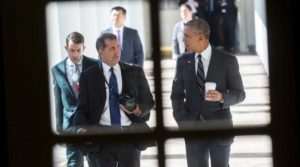The canny undercurrent of Dawn Porter’s documentary THE WAY I SEE IT, about White House photographer Pete Souza, is a consideration of the free press in an era when “fake news” has become a catch phrase for those who see journalists as the enemy of the people. It’s equally canny in the way it contrasts Barack Obama and the man who succeeded him. Unlike Shade, Souza’s coffee-table book on which the film is partly based that pairs Donald Trump’s tweets with Souza’s photos of Obama proving them to be fallacious, there are few references to Trump, but as in the book, they are pointed and they are lethal. The most telling is when Pete Souza, official White House photographer to two to POTUS’s (Reagan and Obama), is analyzing an official picture of Donald Trump staring directly at the camera while in the situation room. Souza, who has been in that very room thousands of times, notes that from the position of the camera, it is situated below the screen on which situations are monitored, meaning that Trump is not paying attention to the country’s business, but rather to the person documenting the moment. It is, as Souza puts it, fishy. How fishy is not spelled out, but for comparison Porter shows us the now iconic pictures of Obama, surrounded by cabinet and advisors in the same room, shot from a different angle, as they watch the operation that killed Osama Bin Laden. None of them are looking at the photographer, if they even remember that he is in the room. Burn.

Pete Souza, Barack Obama
Souza, not the presidents he served, is the subject of this film, but it is only natural that it is filled with his impressions of men whose pictures he snapped. At one point, he notes that the official photographer was one of the few members of the staff who saw the President every day, and, as someone else notes, Souza’s arrival on any scene as inevitably met with hushed silence, because it meant the Commander-in-Chief was only a few footsteps behind him. From state dinners (he caught the shots of John Travolta dancing with Diana at the White House) to the private quarters, Souza was in a unique position to observe Reagan and Obama, and those insights are certainly interesting as a glimpse of their characters. He doesn’t stint on criticism of Reagan’s silence on the AIDS epidemic, for example, but is fulsome in his descriptions of his relationship with Nancy, which he sees as emblematic of the man himself, illustrated with shots he took of them sparring over a chainsaw.
It is Obama, though, with whom he had the closer relationship, highlighted with clips of their easy banter and surprising influence on Souza’s private live. He also had more access during his eight-year tenure as Obama’s Chief Official White House Photographer. Souza averaged 10,000 shots a week. The most moving might be a shot of Obama tightly hugging his older daughter after the Sandy Hook massacre, Souza annotating the moment by telling us that he did not want to let Malia go. The sweetest, one of Obama making snow angels on the White House lawn Melia and Sasha (Souza adds it’s the screensaver on Obama’s iPad). The most fun, Obama playing one-on-one with Reggie King and blocking a shot (after the game, he asked Souza to make sure it was blown up and hung on the wall of jumbo photos decorating staff walls).
A lifelong photojournalist when not documenting POTUS for posterity, Souza is candid when explaining why he has chosen to go so public in his condemnation of Trump, whom he sees as unworthy of the office, and a genuine threat to democracy. He doesn’t rant, but he doesn’t hold back, acknowledging that his cred for impartiality is now over, a consequence he embraces for what he sees as the greater good. Not that he set out to be a political critic. When Souza reads aloud the new rules instituted by Trump for his old job, it is a warning about the costs of losing history. For good measure, historian Doris Kearns Goodwin pops up to provide historical context and a character analysis of the presidents who have come before.
Porter does a fine job of recounting Souza’s life story as the grandson of immigrants who drifted until taking a photography course in college. When he announced his intention of following the art as a profession, his mother remembers being bemused, while his sister remembers that when he left for his master’s she knew that he was never coming back. And he didn’t, moving in quick succession from a small-town paper, to being invited (and hired) by both The Chicago Times and, eventually, the White House.
THE WAY I SEE IT is bittersweet nostalgia for the Obama years tempered with barely suppressed rage at who is now leading this country. It is also a paean to the power of the still image when video is mere clicks away. When Porter juxtaposes video of events and Souza’s shots of those same events it proves that a moment frozen in time, captured at the perfect moment tells a story that needs no words.
Your Thoughts?